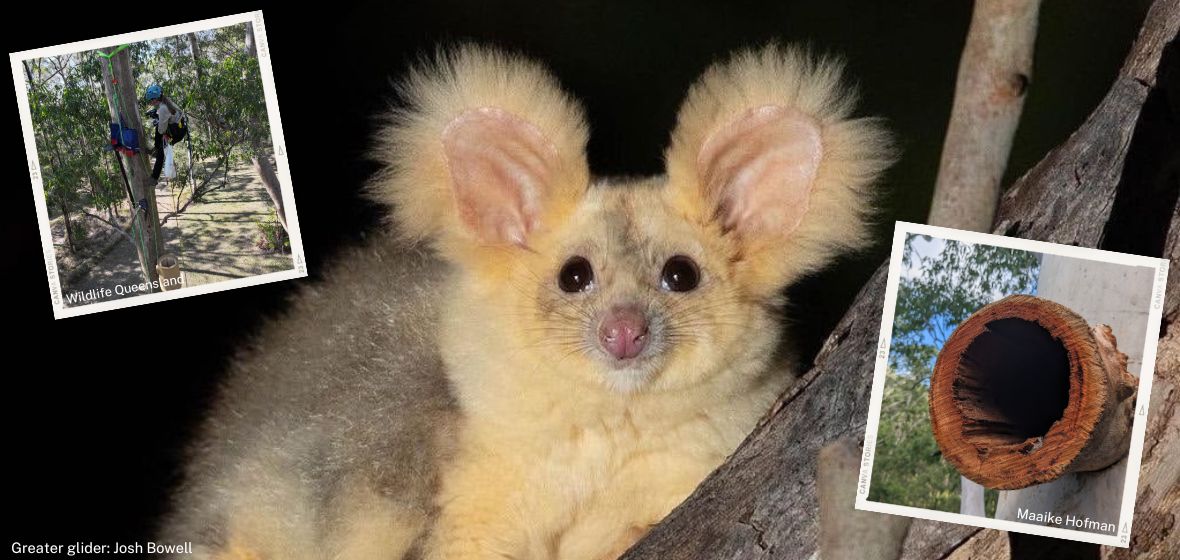
26 October 2023
With World Wildlife Conservation Day approaching on 4 December, it’s time to be aware, reflect, and act on issues threatening the planet’s wildlife biodiversity balance. Amid ongoing threats of urban expansion, bushfires, and deforestation, habitats suitable for hollow-dependent wildlife species are rapidly diminishing due to the decline in old-growth trees.
Creating artificial habitats for wildlife is essential for preserving biodiversity, and it often involves installing nest boxes or carving hollows in trees. The key to success is ensuring that artificial hollows and nest boxes closely emulate natural hollows.
Specific hollow requirements have been well-documented for Australian arboreal fauna. Increasing the number of hollows in an area is crucial for enhancing habitat quality for species like greater gliders (Petauroides Volans) and yellow-bellied gliders (Petaurus australis). These species can utilise up to 20 hollows, and hollow abundance plays a pivotal role in providing suitable habitat.
Wildlife Queensland has adopted a multifaceted approach by installing nest boxes to create artificial habitats and, more recently, by carving hollows.
Nest boxes vs natural hollows
Nest boxes are the most employed form of artificial habitat, crafted from wood or recycled materials meticulously designed to match the specific needs of the target species.
While the success of nest boxes varies among species, documented results for species like the yellow-bellied glider and greater glider in the wild have been somewhat limited.
Natural hollows exhibit higher humidity and better temperature regulation than nest boxes, mainly due to differences in wall thickness. The thermal properties of nest boxes need to be improved to mitigate the predicted heat-loss challenges during hot weather.
Additionally, the height at which nest boxes are installed is vital, as both greater gliders and yellow-bellied gliders prefer higher den sites.
Traditional nest boxes can become uncomfortably warm for gliders, particularly greater gliders, emphasising the importance of using live wood. Wood acts as an insulator, closely mimicking natural hollows.
Carved tree hollows can home greater gliders
“Greater gliders especially are notoriously difficult to create habitat for and are very heat sensitive, so nest boxes may become too hot for them, hence the importance of utilising live wood that can act as an insulator and mimic natural hollows best,” says Wildlife Queensland Project Officer and expert tree climber, Maaike Hofman.
Outside of Queensland, the use of carved tree hollows has yielded positive results, with greater gliders, squirrel gliders, yellow-bellied gliders, sugar gliders, brushtail possums, ringtail possums, and feather tail gliders all finding refuge in these artificial dwellings.
Interestingly, chainsaw-carved hollows have been shown to offer more stable microclimates than artificial nest boxes and hollow log boxes1. The superior thermal insulation they provide closely mirrors the conditions in natural hollows.
Carving tree hollows
One method involves using chainsaws to create a wedge out of a tree trunk, trimming the wedge, carving an entrance, and connecting the top entrance to the bottom chamber. Another method entails carving a cavity in the trunk and inserting a salvage log with glue and screws.
Alternatively, live limbs can be cut, and entrances can be carved into the cut limb. A tool known as the Hollow Hog can also be used to carve hollows efficiently.
Wildlife Queensland project officers have started to use carved artificial tree hollows in some glider habitat areas.
Wildlife Queensland Project Officer, Hannah Thomas, will conduct carved hollow installations and will place specialised nest boxes within glider habitat south of Brisbane in early November.
Stay tuned for more Wildlife Queensland news articles on the subject. Don’t forget to check out our Instagram and Facebook pages for photos taken by our project officers, showcasing how Queensland’s arboreal species are making use of these artificial hollows.
How you can support the Queensland Glider Network and glider conservation
- For information about Wildlife Queensland’s conservation work with gliders and to learn more about these fascinating marsupials, please visit our Queensland Glider Network program page.
- Help support our Queensland Glider Network by symbolically adopting a glider for one year with a tax-deductible donation.
- Read our Revegetation Guide to the Threatened Gliders of Southern Queensland to learn what you can do to help them.
- Griffiths, Stephen R, Lentini, Pia E, Semmens, Kristin, Watson, Simon J, Lumsden, Linda F & Robert, Kylie A 2018, ‘Chainsaw-carved cavities better mimic the thermal properties of natural tree hollows than nest boxes and log hollows’, Forests, vol. 9, no. 5, p. 235.
